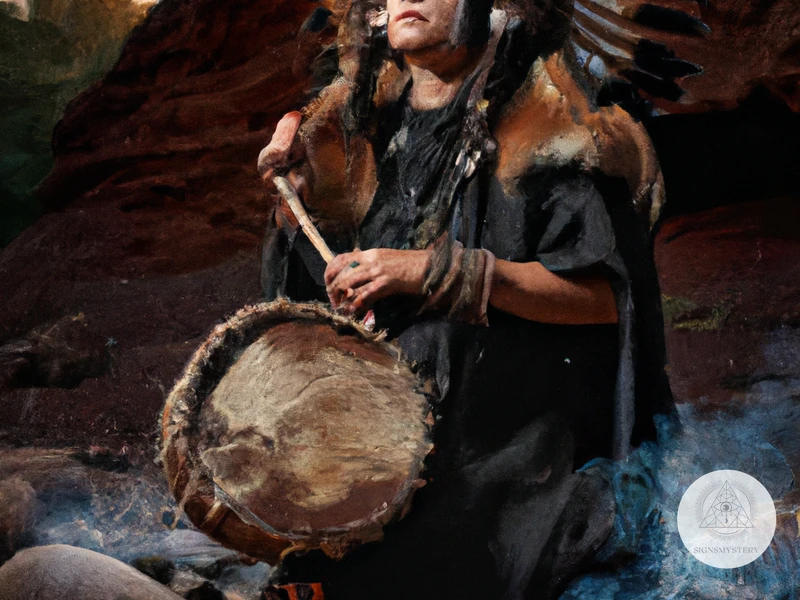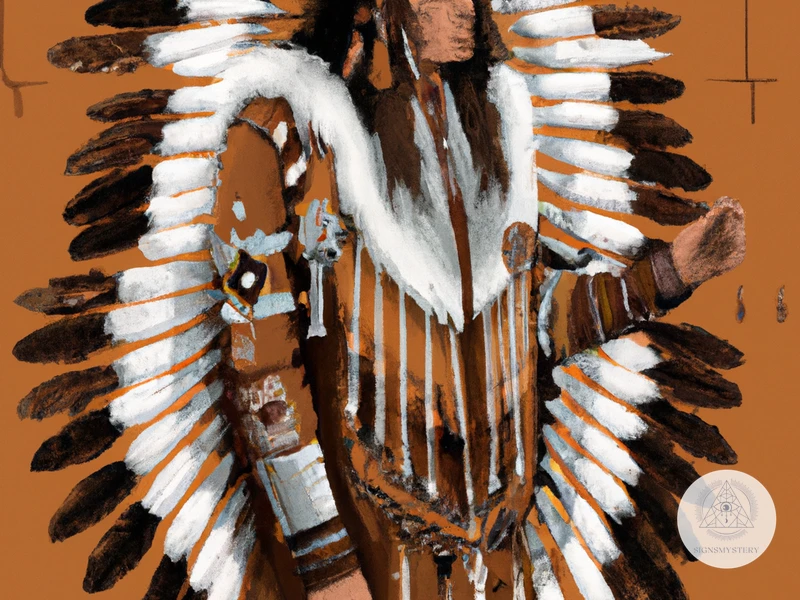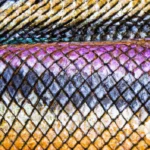Shamans have long utilized attire fashioned from fur and pelts to enhance their connection to nature and the animal spirits they seek to communicate with. While some may view this practice as controversial, others argue that it is an important aspect of shamanic tradition that offers spiritual security and protection. In this article, we will explore the significance of shamanic attire and how fur and pelts can be incorporated into ritual costumes. We will also delve into the various types of fur and pelt commonly used in shamanic practices, and discuss the ethical considerations involved in their sourcing and care.
The Importance of Shamanic Attire

Shamanic attire plays a significant role in a shaman’s practice. It serves as a form of symbolism, spiritual protection, and a means of connecting with animal and nature spirits. Shamans wear attire made of fur and pelts to embody the attributes of the animals and spirits they work with. For instance, a bear skin may represent strength, courage, and power, while a fox fur may signify cunning and agility. The attire also serves as a form of protection during shamanic journeys to the spirit world. Shamans believe that wearing fur and pelts will protect them from negative energy and entities. It is essential to understand the significance of shamanic attire and how to responsibly incorporate it into spiritual practice.
1. Significance in Rituals
In shamanic practices, the use of fur and pelts holds great significance. The process of selecting and wearing particular animal pelts or fur serves as a powerful tool in spiritual rituals. The symbolism of each animal and their fur or pelt is utilized to achieve a deeper level of connection with the animal, and ultimately nature itself.
The wearing of furs often signifies the shaman’s ability to communicate with and take on the aspects of the animal from which the fur was taken. This connection helps the shaman to gain insights and guidance from the animal spirits during rituals. The overall purpose of wearing furs and pelts is to assist in developing a stronger spiritual connection between the wearer and the spiritual world.
Animal symbolism is an important component in shamanic practices. The specific fur or pelt that a shaman chooses to wear has significant symbolic meaning, representing certain characteristics of the animal. For instance, wolf fur is often worn to represent strength, loyalty, and leadership. On the other hand, rabbit fur represents fertility, agility, and quick thinking.
In shamanic rituals, fur and pelts can be worn as a form of spiritual protection. The various materials can act like a shield for the shaman, providing a sense of safety and security. Additionally, the different textures and smells of furs and pelts may have specific therapeutic effects, as they help to create a sensory experience that can stimulate the mind and heighten ritual awareness.
The use of furs and pelts in shamanic practices adds a powerful layer of symbolism and connection to the natural world. However, it is important to source these materials ethically and with proper care. For more information on ethical sourcing and care for fur and pelts in shamanic practices, please refer to /ethics-fur-pelts-shamanic-practice/.
2. For Protection
Fur and pelts are often used in shamanic attire for their protective properties. The use of animal fur in shamanic practices is rooted in the belief that the spirits of animals can provide protection to humans. In traditional shamanic cultures, wearing fur was considered to offer physical and spiritual protection from harm.
The use of fur and pelts in shamanic costumes is not simply for decoration but serves a practical purpose as well. The fur provides protection against the harsh weather conditions and can keep the shaman warm and dry during ceremonies. It is believed that the fur of certain animals possess specific qualities that can offer additional benefits to the wearer.
For example, wolf fur is highly prized for protection and is commonly used in shamanic ceremonies. The wolf is considered a powerful spirit animal in many cultures, and its fur is thought to offer the wearer the qualities of courage and strength. Similarly, the bear is revered for its resilience, and its fur is believed to offer the wearer protection against negativity and danger.
It is essential to understand the ethical sourcing and proper care of fur and pelts used in shamanic practices. Shamans need to obtain the fur in an ethical and respectful way, without causing harm to the animal or the environment. Proper care is essential to ensure the fur remains in good condition and will continue to provide the wearer with long-term protection.
The use of fur and pelts in shamanic costumes for protection is based on traditional beliefs that the spirits of animals can provide humans with physical and spiritual protection. By incorporating the right type of fur, shamans can take advantage of the protective qualities that are believed to be inherent in these materials. But the ethical sourcing and proper care of these materials should also be kept in mind.
3. Enhancing Connection to Animals and Nature
Shamanic practices often involve connecting with the spirit of animals and nature. Wearing clothing made from fur and pelts can help facilitate this connection. The texture and feel of the fur against the skin can create a sensory experience that connects the wearer to the animal world.
According to animal fur symbolism in shamanism, wearing fur can help the wearer take on the qualities of the animal whose fur they are wearing. For example, wearing a fox fur may help the wearer tap into the fox’s slyness and quick thinking. This can aid the wearer in performing shamanic tasks such as divination and healing.
In some shamanic traditions, certain animals are considered to be particularly powerful spirit allies. Coyote and fox pelts are commonly used in Native American shamanic practices due to their association with trickster energy. Similarly, bear pelts are often used in Siberian shamanism due to their association with strength and power.
However, it is important to note that not all shamanic practitioners believe in wearing fur as a means of enhancing connection to animals and nature. Some argue that it is possible to connect with animal spirits without physically wearing their fur. This is particularly relevant in modern times, where concerns about animal welfare have led many people to question the ethics of using animal products.
The use of fur and pelts in shamanic attire is a complex issue that involves considerations of ethics, spirituality, and culture. As with any spiritual practice, it is up to the individual practitioner to decide what feels right and resonates with their personal beliefs and values. For those who do choose to use fur and pelts in their shamanic attire, it is important to be mindful of both the care and maintenance of the products, as well as the ethical sourcing of the materials.
Types of Fur and Pelt
When it comes to shamanic attire, the types of fur and pelt utilized are significant. Fox fur often symbolizes adaptability and quick-thinking, while wolf fur is associated with intuition and the ability to work in a pack. Bear fur represents strength and grounding, deer pelt can symbolize gentleness and sensitivity, and rabbit fur is often used for its association with cleverness and cunning. Each type of fur and pelt holds its own symbolic significance and can enhance the wearer’s connection to animal spirits. It is important to note that the ethical sourcing of fur and pelt should be a priority, and there are alternatives available for those who prefer not to use real animal products. For those interested in the history and traditions of fur and pelts in shamanism, check out this article.
1. Fox Fur
Fox Fur in Shamanic Attire
Fox fur is one of the most commonly used materials in creating shamanic attire. This type of fur is highly valued by shamans for its unique energy and symbolism. Foxes are known for being quick and agile, and their fur is often associated with speed and cunning intelligence.
In shamanic practices, fox fur is typically used to enhance one’s focus and mental clarity. It is believed to help the wearer connect with the spiritual realm and receive guidance from animal spirits. Additionally, fox fur is often used to create pieces that represent the fox spirit, which is associated with adaptability and resourcefulness.
When using fox fur in shamanic attire, it is important to consider ethical sourcing practices. Many shamans place a high value on respecting and honoring the animals from which their materials are sourced. This may involve using only fur from animals that have died naturally or as a result of hunting for sustenance, rather than using materials from animals that have been raised and killed solely for their fur.
If you are considering incorporating fox fur into your shamanic attire, it is important to handle and clean it properly to maintain its quality. You may also consider alternatives to fox fur, such as sourced from animals that are not endangered or using faux fur.
Related Link: The Conservation Role of Shamanism in Endangered Species
2. Wolf Fur
Wolf Fur has been a popular material for shamanic attire for centuries. Wolves are revered in many cultures as powerful and wise animals with strong spiritual connections. Their fur is thick and warm, making it ideal for cold weather and protection against the elements. It is also durable, which makes it ideal for use in ritual and ceremonies that involve movement and activity.
In shamanic practices, wolf fur is often used as a symbol of strength, courage, and perseverance. Wearing wolf fur during a shamanic journey can help the individual tap into the energy and spirit of the wolf, allowing them to take on its qualities and gain insights and wisdom from the animal.
Wolf fur can be incorporated into shamanic attire in a number of ways. It can be used to adorn clothing, such as a cloak or shawl. It can also be worn as a headdress or hat. Additionally, wolf fur can be used to create a pouch or bag for holding ritual items or personal belongings.
It is important to note that using wolf fur in shamanic attire should be done ethically and responsibly. Some tribes and cultures have strict guidelines for how and when wolf fur can be used. It is important to research and understand the laws and regulations around using wolf fur before incorporating it into your attire.
If it is not possible to obtain ethically sourced wolf fur, there are alternatives available, such as synthetic fur or other types of animal fur that are sourced more responsibly. It is always better to choose alternative materials rather than using fur that has been obtained through unethical means.
Wolf fur is a powerful and important material for shamanic attire. It has been used for centuries to connect shamanic practitioners with the spirit of the wolf and to gain insight and wisdom. However, it is important to use it responsibly and adhere to ethical guidelines for the sourcing and use of this material.
3. Bear Fur
Bear Fur holds a vital role in Shamanic rituals. It has been used for centuries in Native American culture, especially by tribes in the Pacific Northwest. Bears embody strength, courage, and introspection, which are the qualities that many Shamans seek to imbibe in their attire. Wearing bear fur is believed to connect the Shaman to the animal’s spirit and its qualities.
Bear hides are often used for making shamanic drums as the hide’s thickness provides a rich sound. It was also used to cover tipi floors and walls in Native American cultures. Shamans have also used bear fur as a cloak or shawl, and it is said that wearing one provides physical and spiritual protection. The bear fur’s thickness and warmth make it perfect for harsh weather conditions, particularly in the colder months.
However, the use of bear fur has caused controversy over time. Ethical concerns arise over hunting bears for their hides and using them in Shamanic attire. The legal issues surrounding the use of bear fur differ from state to state and tribe to tribe. Alternative options are available that are cruelty-free and still have connections with animal spirits.
Wearing bear fur in shamanic costumes holds significant importance and sacredness. However, the use of bear fur should be done ethically with a deep respect for the animal and its environment. Shamans must use their discretion and judgment when sourcing bear fur for their attire. An internal link to the article on healing animal pelts in shamanic practices can provide insight into ethical practices surrounding animal pelts in Shamanism.
4. Deer Pelt
Deer pelt is another popular choice for shamanic attire. It is known for its soft texture and durability. Deer pelt is commonly used to make moccasins or boots for protection during rituals as well as for the comfort of the wearer. The softness of the pelt also makes it ideal for creating a shawl or cloak for warmth during colder outdoor ceremonies.
Additionally, deer pelt has symbolic meaning in shamanism. It is often associated with grace, gentleness, and sensitivity, making it a common choice for those seeking to strengthen their connection to these qualities. Some shamans also believe that wearing deer pelt can enhance agility and balance.
When using deer pelt for shamanic attire, it is important to consider ethical sourcing. Look for high-quality pelt from a reputable source to ensure that the animal was not mistreated. If possible, choose pelt that was obtained through traditional hunting or other sustainable means.
If you prefer not to use real animal products for ethical reasons, there are alternatives to deer pelt that can be used in shamanic attire. However, it is important to note that some practitioners believe that only real animal products have the spiritual power necessary for shamanic rituals. Ultimately, the decision of which materials to use should be based on personal beliefs and ethical considerations.
Related link: Animal Spirits and Fur Pelts in Shamanism
5. Rabbit Fur
Rabbit fur is a popular choice for shamanic costumes and ritual attire. It is soft and lightweight, making it comfortable to wear for extended periods. Rabbit fur is also very durable and easy to work with.
When used in shamanic attire, rabbit fur can represent resourcefulness and fertility. It can provide a connection to the rabbit spirit, which is seen as quick and agile.
Rabbit fur can be incorporated into shamanic attire in a number of ways. A rabbit fur vest or scarf can be worn over a plain outfit to add texture and visual interest. It can also be used to trim a shamanic cloak or headdress.
To care for rabbit fur, it is important to keep it clean and dry. Any dirt or moisture can damage the fur and cause it to mat. If the fur becomes wet, it should be gently patted dry with a towel and allowed to air dry away from direct sunlight. Rabbit fur should also be stored in a cool, dry place when not in use.
When sourcing rabbit fur for shamanic attire, it is important to ensure that it has been obtained ethically and with respect for the animal. Alternatively, there are synthetic alternatives available that can provide a similar look and feel without the ethical concerns.
Internal link: Shamanic Drum Making: Real Animal Hide – Pros and Cons
How to Incorporate Fur and Pelts in Shamanic Attire

There are many ways to incorporate fur and pelts into shamanic attire to enhance the connection to animals and nature. Adding accents to clothes is one option, such as attaching a fur collar to a jacket or sewing fur trim to a dress. Creating a shawl or cloak out of fur or pelt is another possibility, providing warmth and a visually striking addition to the attire. Wearing a fur hat or headband not only adds to the overall aesthetic, but also keeps the head and ears protected from the elements. A fur bag or pouch can also be created to hold sacred objects or tools, further integrating the natural world into the practice. Lastly, fur and pelts may also be used as a rug or mat for rituals and ceremonies. Experiment with incorporating different types of fur and pelt to find what resonates best with individual intentions and traditions.
1. Add Accents to Clothes
When incorporating fur and pelts into shamanic attire, adding accents to clothes is a popular and simple approach. This entails adding small amounts of fur to clothing items for a subtle yet noticeable effect. For instance, adding fur trim to a cloak or jacket can immediately transform it into a shamanic garment. This method can be employed for both formal and casual wear.
To start, select a garment that you want to accentuate with fur. This could be a jacket, vest, or skirt. Next, identify the areas of the garment where you want to add the fur accents. Typically, adding fur around the collar, cuffs, or hemline of a garment works best. You can use sewing needles or fabric glue to attach the fur to the garment.
When selecting fur for accents, it is important to choose a type of fur that complements the color and texture of the garment it will be attached to. It is best to choose a type of fur that is similar in texture to the garment it will be attached to so that it blends in seamlessly.
Adding fur accents to clothes is an excellent way to incorporate shamanic elements into your everyday wardrobe. With just a little creativity and some basic sewing or gluing skills, you can easily transform any garment into a distinctive and meaningful piece of shamanic attire.
2. Create a Shawl or Cloak
One of the best ways to incorporate fur and pelt into shamanic attire is to create a shawl or cloak. This type of garment not only adds warmth but also serves as a statement piece.
Materials Needed:
To create a shawl or cloak, you will need the following materials:
- Fur or pelt of your choice
- Fabric for lining
- Thread
- Sewing machine or needle and thread
- Scissors
- Measuring tape
- Pins
Steps:
1. Measure the length and width of the shawl or cloak that you want to create. It’s best to measure yourself or the person you are creating the shawl for to ensure a proper fit.
2. Cut the fabric of your choice for the lining of the shawl or cloak. The fabric should match the length and width of the fur or pelt that you will be using.
3. Pin the fur or pelt to the lining fabric. Make sure that the fur or pelt is facing inward towards the lining.
4. Sew the fur or pelt to the lining fabric, leaving a small seam allowance.
5. Once the fur or pelt is attached to the lining fabric, fold the fabric in half, so that the fur or pelt is on the inside.
6. Sew the sides of the shawl or cloak together, leaving a gap at the top for the neck.
7. Try on the shawl or cloak to ensure a proper fit. If needed, make any adjustments to the length or width.
8. Sew the gap at the top of the shawl or cloak together to create a neckline.
Shawl or Cloak Variations:
There are many variations that you can make to a shawl or cloak using fur and pelt. Some ideas include:
- Adding a hood to the shawl or cloak for added warmth and protection
- Adding tassels or fringe to the bottom of the shawl or cloak for a decorative touch
- Using multiple pieces of fur or pelt to create a patchwork effect
- Addingbeads or other embellishments to the shawl or cloak for a personalized touch
Subscribe to Our Newsletter
Sign up to receive the latest news and updates.
Creating a shawl or cloak using fur or pelt allows for a unique and personalized piece of shamanic attire. With proper care and handling, this one-of-a-kind garment can last for years to come.
3. Wear a Fur Hat or Headband
Wearing a fur hat or headband is a classic way to incorporate fur and pelts into shamanic attire. These accessories can be made from a variety of animal furs and can greatly enhance the overall look and feel of the outfit.
Here are some steps to consider when wearing a fur hat or headband:
1. Choose the right fur: The type of fur you choose for your hat or headband will depend on personal preference and the type of ritual or ceremony you are attending. Some popular options include wolf or bear fur for their symbolic meaning and soft texture.
2. Consider the design: The design of your fur hat or headband is also important. You may choose a simple headband with a single strip of fur or a more elaborate hat with multiple layers and embellishments.
3. Coordinate with your outfit: It’s essential to coordinate your fur hat or headband with the rest of your shamanic attire. Choose colors and patterns that complement your other pieces.
4. Wear with confidence: Finally, wear your fur hat or headband with confidence. It’s an essential part of the shamanic attire and can greatly enhance your connection to the spiritual world.
When it comes to wearing fur hats and headbands, it’s important to remember to take proper care of them. Fur should always be stored in a cool, dry place and away from direct sunlight to prevent damage. If your fur hat or headband becomes dirty, use a soft brush to gently remove any debris and consider taking it to a professional fur cleaner for deep cleaning.
It’s also important to consider the ethics of using fur and pelts in shamanic attire. Make sure to source your products from ethical and sustainable sources and be mindful of the impact that the fur industry can have on animal populations and ecosystems.
Wearing a fur hat or headband can greatly enhance the overall look and feel of shamanic attire. Choose the right fur, design, and coordination to make the most out of this accessory. And always remember to take proper care of your fur items and consider the ethical implications of their use.
4. Make a Fur Bag or Pouch
Another great way to incorporate fur and pelt into your shamanic attire is by making a fur bag or pouch. This not only adds a stylish element to your outfit, but also provides a practical solution for carrying around shamanic tools and ritual offerings.
To make a fur bag or pouch, you will need the following materials:
- Fur or pelt: Choose a piece of fur or pelt that is large enough to make a bag/pouch and is suitable for carrying items.
- Fabric: You will need additional fabric to line the interior of the bag/pouch.
- Needle and thread: Use a needle and thread that are suitable for sewing through the thickness of the fur/pelt.
- Scissors: A good pair of scissors will be needed to cut the fur/pelt and fabric.
- Decorative elements: If desired, add any decorative elements such as beads, feathers, or symbols.
Once you have gathered the necessary materials, follow these steps:
- Cut the fur: Cut the fur/pelt to the desired size and shape. This will be the exterior of your bag/pouch.
- Cut the lining fabric: Cut the fabric to match the size and shape of the fur/pelt. This will be the interior of your bag/pouch.
- Sew the lining: Sew the lining fabric right sides together. Leave a small opening for turning the bag/pouch right side out.
- Attach the lining to the fur: With the fur/pelt turned inside out, sew the lining fabric to the fur along the top edge of the bag/pouch.
- Turn the bag right side out: Carefully turn the bag/pouch right side out through the small opening left in the lining.
- Finish and embellish: Sew up the small opening in the lining and add any decorative elements desired.
Now that you have a fur bag or pouch, you can add it to your shamanic attire for a practical and stylish addition.
5. Use as a Rug or Mat
Using fur and pelt as a rug or mat in Shamanic attire is a unique way to incorporate the animal kingdom into a ritual. The softness of the fur provides comfort, while the texture adds depth to the overall design. Rugs or mats made of fur and pelt serve a practical purpose in providing warmth during long ceremonies.
One type of fur that works well for this purpose is bear fur. Bear rugs are a common decorating item in some homes, and the use of a bear skin rug in Shamanic attire would certainly make a powerful statement. Wolf fur can also be used for this purpose, as it provides a beautiful blend of light and dark tones.
Creating a rug or mat out of fur and pelt requires careful consideration and preparation. First, the fur should be properly cleaned and treated to ensure that it will last for years to come. This can be done by a professional furrier or by following specific instructions for cleaning and tanning the fur at home.
When incorporating a fur rug or mat into Shamanic attire, it is important to place it in a position that is respectful to its purpose and meaning. For example, the rug may be used as a central focal point in a ceremony, or it may be placed in a specific location based on the symbolic meaning of the animal whose fur it is made from.
Another consideration when using fur and pelt as a rug is the texture and thickness of the fur. This can be adjusted to suit the needs of the ceremony, with thicker fur being used in colder climates and thinner fur in warmer climates. And if a fur rug or mat is not suitable for a particular ritual, alternatives like faux fur can be used instead.
Using fur and pelt as a rug or mat in Shamanic attire is a unique and meaningful way to incorporate the animal kingdom into a ritual. Proper ethical considerations and care should be taken when sourcing and handling fur and pelt, and its placement in a ceremony should be done with respect and purpose.
Fur and Pelt Care and Ethics
Caring for fur and pelt is of utmost importance in shamanic attire, not only for ensuring its longevity and continued use but also for ethical reasons. Proper handling and cleaning are crucial to maintaining the quality of the fur or pelt. One should avoid using harsh chemicals and opt for natural cleaning methods. A gentle brush or a damp cloth with mild soap can do the trick. One can also use specialized fur cleaning services for more delicate furs. It is also essential to source the fur and pelt ethically, ensuring that it was obtained through sustainable and humane methods. If that is not possible, one can opt for faux fur as an alternative. By taking care of fur and pelt in a mindful and ethical way, one can honor the spirit of the animal and continue to incorporate it into shamanic attire with respect and gratitude.
1. Proper Handling and Cleaning
Proper handling and cleaning of fur and pelt is crucial to maintain their quality and appearance, as well as to ensure they are sanitary and safe to use in shamanic attire. Here are some guidelines for proper handling and cleaning of fur and pelt:
Handling:
1. Always handle fur and pelt with clean, dry hands to avoid transferring oils and dirt.
2. Avoid rubbing or pulling on the fur or pelt, as this can damage the hairs or weaken the hide.
3. When storing or transporting fur and pelt, avoid folding or compressing it, as this can cause the hairs to mat or the hide to crack.
4. Keep fur and pelt away from direct sunlight, moisture, and heat to prevent fading, mold, and mildew.
Cleaning:
1. Brush fur and pelt gently with a soft-bristled brush to remove dirt and debris.
2. For small stains, spot clean with a damp cloth and mild detergent, then rinse thoroughly and let air dry.
3. For larger stains or general cleaning, seek out a professional fur cleaner who specializes in the type of fur or pelt you have.
4. Never use heat or chemicals to clean fur or pelt, as this can damage the hairs or hide.
Proper handling and cleaning of fur and pelt requires delicacy and care to ensure that they remain in good condition and safe for use in shamanic attire. By following these guidelines, you can maintain the quality and beauty of your fur and pelt for years to come.
2. Ethical Sourcing of Fur and Pelt
When it comes to sourcing fur and pelt for shamanic attire, it’s important to consider the ethical implications. Here are some things to keep in mind:
1. Know the source
It’s important to know where the fur and pelt are coming from. Be sure to ask the supplier or seller about their sourcing practices. Ideally, the source should be local and the animals should have been raised in humane conditions.
2. Consider alternative options
If sourcing fur and pelt is not possible in an ethical manner, consider using alternative materials. There are many faux fur options available that can still provide the look and feel of real fur without contributing to animal cruelty.
3. Look for certifications
Some organizations offer certifications or labels for furs and pelts that have been ethically sourced. Look for these labels when purchasing materials and products.
4. Choose recycled materials
Another option is to use recycled fur and pelt. This way, no new animals are being harmed in order to create the attire.
By taking these ethical considerations into account, we can ensure that the beauty of shamanic attire does not come at the cost of animal welfare. It’s important to remember that animals are sentient beings who deserve respect and humane treatment in all aspects of life.
3. Alternatives to Fur and Pelt
As people become more conscious about animal welfare and the environment, the demand for faux fur and synthetic materials as an alternative to fur and pelt has grown. Synthetic materials like polyester, acrylic, and nylon can replicate the texture and look of real fur, and are more affordable compared to their authentic counterparts.
Faux Fur: Faux fur is an animal-friendly alternative to real fur, made from synthetic fibers. It is less expensive and doesn’t require the same maintenance as real fur. It’s also available in a wide range of colors and styles, giving designers and creators more flexibility in their work. However, it’s worth noting that the production of faux fur can still have environmental impacts, as it is made from petroleum-based materials.
Wool: Wool is another alternative material that has been used traditionally in shamanic attire. It’s a natural and renewable resource, making it a more sustainable option. Wool can be used to create shawls, cloaks, and hats that are warm and comfortable for outdoor rituals. Like fur, wool can also be dyed to create different colors and patterns.
Plant-Based Materials: Plant-based materials such as cotton, hemp, and bamboo can also be used in shamanic attire. They offer a more environmentally conscious and vegan-friendly alternative to fur and pelt. These materials are typically less durable than wool or faux fur, but with proper care, they can still be used in garments and accessories.
It’s important to consider the alternatives to fur and pelt when creating shamanic attire, both for ethical and environmental reasons. While some people may prefer the look and feel of real fur, there are many viable alternatives that can still create the desired effect and meaning in shamanic rituals.
Conclusion
In conclusion, the use of fur and pelts in shamanic costumes and ritual attire holds great significance in enhancing the spiritual experience. As we have seen, fur and pelts provide not only physical protection but also serve as a channel for deeper connection to animals and nature.
It is important to note the different types of furs and pelts available and how to incorporate them into shamanic attire through various methods like adding accents, creating shawls, wearing hats or headbands, making bags, and using them as rugs or mats. However, we must also be mindful of the proper handling and cleaning procedures, as well as ethical sourcing of fur and pelts.
For those who have ethical concerns, there are alternative materials that can be used such as faux fur or using non-animal materials to create the desired effect. Ultimately, the decision to use fur and pelts in shamanic attire is a personal choice and should be made with awareness and respect for the animals and their role in the ecosystem.
Overall, incorporating fur and pelts into shamanic attire can enhance the spiritual experience and deepen the connection to nature and the animals that inhabit it. It is a powerful tool that can be used with respect and reverence for the animals and their contributions to the world we inhabit.
Frequently Asked Questions
What is the significance of shamanic attire?
Shamanic attire holds deep symbolic meaning and facilitates spiritual connection with nature, amplifying the shaman’s ability to perform his or her duties.
What types of fur and pelt are commonly used in shamanic attire?
Fox, wolf, bear, deer and rabbit are some of the most commonly used furs and pelts in shamanic attire due to their special meaning and spiritual significance.
How can I incorporate fur and pelts in my shamanic attire?
Fur and pelts could be used as accents to clothes, worn as a shawl, cloak or hat, made into a bag or pouch or even used as a rug or mat. The possibilities are endless.
How should I clean and take care of my fur and pelt attire?
It is important to follow specific care instructions for each type of fur or pelt in order to preserve its quality and shine. Always consult with a professional furrier and avoid using chemical cleaning products.
What are the alternative materials to fur and pelt?
Faux fur, synthetic fibers, and natural materials such as cotton or wool can be used as alternatives to fur and pelt in shamanic attire.
Where can I source ethical and sustainable fur and pelt?
It is important to research furriers and sources to ensure ethical and sustainable practices for both people and animals are upheld. Look for brands with certifications or that use recycled materials.
What is the history of using fur and pelt in shamanic attire?
Fur and pelt have been used in indigenous cultures for centuries due to their ability to enhance a connection with nature and facilitate spiritual connection with the spirit world.
How does shamanic attire enhance protection during spiritual rituals?
Shamanic fur and pelt attire is believed to have protective properties that shield the shaman from negative energies and spirits, enhancing the success of the ritual.
What does a fur hat symbolize in shamanic attire?
In shamanic traditions, a fur hat represents the shaman’s connection to the spirit world and his or her heightened intuition and spiritual abilities.
What is the role of the shaman in indigenous cultures?
The shaman is a healer, guide, and spiritual leader who bridges the gap between the physical and spiritual worlds. The shaman uses various tools and practices, including the wearing of special attire, to connect with the spirit realm and facilitate healing.










